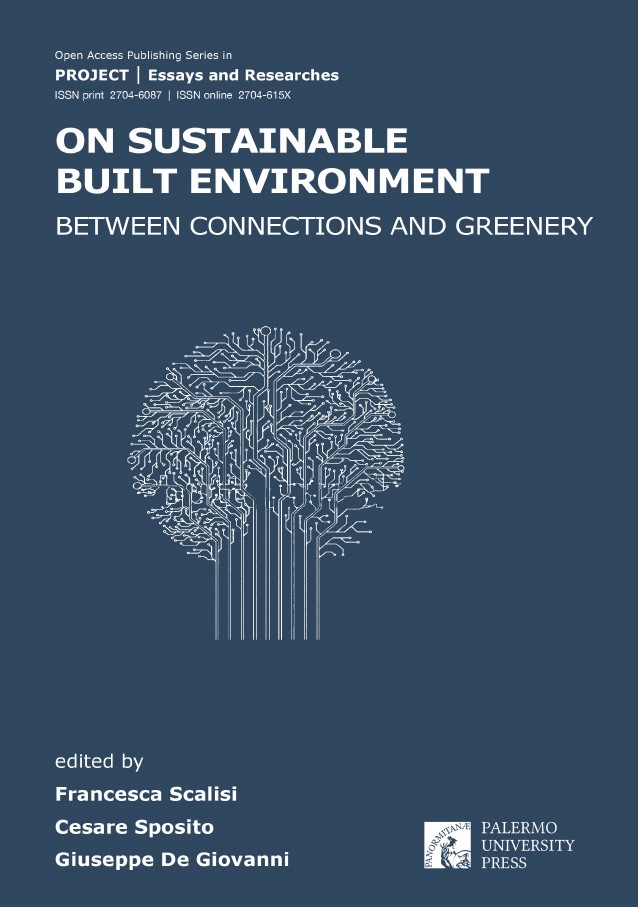
Title
Living in the age of complexity. Indoor air quality between technology, people and nature
DOI
doi.org/10.19229/978-88-5509-446-7/722022
Keywords
living, environment, sustainable architecture, indoor air quality, technology
Abstract
Over the last half-century, society has faced the scene of its future self-destruction and the unique condition of being aware of it, witnessing the alarms and warnings for our well-being and lifestyles. The anthropic landscape remains in a state of physical and environmental degradation, with settlements and communities experiencing social distress, pollution and inequality. Physical space, and its formal and social outcomes, are the product of human activity on the environment, adapted and manipulated to build settlements according to unsustainable lifestyles. Before the second industrialisation, human settlements were created by adapting human needs to the characteristics of the natural environment without compromising resources. Today, such ability to respectfully inhabit places is lost. The rate of technological innovation is weakened by consumerist logic, rather than strengthened in the direction of well-being and impact, and the construction industry is not immune to this trend. Health, safety and sustainability are the tracks that should guide development and innovation, both social and technological, the paper aims to rediscover and update these concepts within the construction process, to pursue a new balance between the built and natural environment.
Section
Architecture | Essays & Viewpoint
pp. 30-45
Author(s)
Alberto De Capua, Lidia Errante
Author(s) Biography
Alberto De Capua, Architect and PhD, is an Associate Professor at the Department of Architecture and Territory, ‘Mediterranea’ University of Reggio Calabria (Italy). He is a member of the Board of Directors of the University of Reggio Calabria and since 2020 is the Vice- Coordinator of the Course of Study in Design L4. He is the Scientific Director of the Innovation Centre for Sustainable Building Green Home for the University of Reggio Calabria. Mob. +39 339/624.25.69 | E-mail: adecapua@unirc.it
Lidia Errante,Architect and PhD, is a Research Fellow in Sustainable Building at the Department of Architecture and Territory of the ‘Mediterranea’ University of Reggio Calabria (Italy). She carries out research activities in the field of quality of urban life and socio-spatial studies aimed at the design of urban public space and the residential relevance of public housing districts. She works on sustainable redevelopment of the built environment using green technologies. Mob. +39 388/18.20.607 | E-mail: lidia.errante@unirc.it
References
Alberti, L. B. (1966), L’architettura [or. ed. De re aedificatoria], Il Polifilo, Milano 1966, libro I, cap. VI, vol. 2, I, p. 50.
Berglund, B., Lindvall, T., Samuelsson, I. and Sundell, J. (1991), “Prescriptions for healthy buildings”, in Berglund, B. and Lindvall T. (eds), Proceedings of CIB Conference Healthy Buildings ’88 – Conclusions and Recommendations for Healthier Buildings, Swedish Council for Building Research, Stockholm, vol. 4, pp. 5-14.
Bragança, L., Pinheiro, M., Mateus, M., Amoêda, R., Almeida, M., Mendonça, P., Cunha, A. M., Baio Dias, A., Farinha, F., Gervásio, H., de Brito, J., Guedes, M. C. and Ferreira, V. (eds) (2010), Portugal SB10 – Sustainable Building – Affordable for All – Low cost solution, Multicomp.
Broggi, L. (1888), Sull’indirizzo artistico e costruttivo dei nuovi quartieri, Milano.
Campioli, A. (2005), “Presentazione”, in Lavagna, M., Sostenibilità e risparmio energetico, Libreria Clup, Milano, pp. 11-13.
De Capua, A. (2019), La qualità ambientale indoor nella riqualificazione edilizia, Legislazione Tecnica, Roma.
De Capua, A. (2008), Tecnologie per una nuova igiene del costruire, Gangemi, Roma.
ECA – European Collaborative Action (2003), Ventilation, Good Indoor Air Quality and Rational Use of Energy, Report No 23. [Online] Available at: aivc.org/sites/default/files/members_area/medias/pdf/Inive/ECA/ECA_Report23.pdf [Accessed 28 July 2022].
European Commission (2019), The European Green Deal, document 52019DC0640, 640 final. [Online] Available at: eur-lex.europa.eu/legal-content/EN/TXT/?uri=CELEX%3A52019DC0640 [Accessed 15 July 2022].
Faloppa, F. (2016), “Perché oggi”, in Langer, A., Non per il potere, Chiarelettere, Milano, pp. IX-XIV.
Gould, S. J. and Vrba, E. (2008), Exaptation – Il bricolage dell’evoluzione, Bollati Boringhieri, Torino.
IEA – International Energy Agency (2022), Global Energy Review – CO2 Emissions in 2021. Global emissions rebound sharply to highest ever level, International Energy Agency Publications.
Kimball, D. (1929), “Air-conditioning, its future in the field of human comfort”, in Heating, Piping and Air-conditioning.
Lanza, A. (2006), Lo sviluppo sostenibile, il Mulino, Bologna.
Latouche, S. (2014), La scommessa della decrescita, Feltrinelli, Milano.
Latouche, S. (2013), Usa e getta – Le follie dell’obsolescenza programmata, Bollati Boringhieri, Torino.
Manzini, E. (2007), “Sviluppo sostenibile e discontinuità”, in Vezzoli, C. and Manzini, E., Design per la sostenibilità ambientale, Zanichelli, Bologna, pp. 2-16.
Manzini, E. (1997), “Leapfrog – Anticipazioni di un futuro possibile”, in Domus, n.789, pp. 44-47.
Molina, C., Pickering, C. C. A. C., Valbiørn, O. and De Bortoli, M. (1989), Sick Building Syndrome – A Practical Guide, Report No. 4, Commission of the European Communities. [Online] Available at: aivc.org/sites/default/files/members_area/medias/pdf/Inive/ECA/ECA_Report4.pdf [Accessed 28 July 2022].
Morton, T. (2019), Cosa sosteniamo? Pensare la natura al tempo della catastrofe, Aboca Edizioni, Sansepolcro (AR).
Nardi, G. (1990), “Costruire distrattamente – Incongruenze e contraddizioni nell’impiego odierno delle tecniche progettuali e costruttive”, in Baglioni, A. and Piardi, S. (eds), Costruzione salute, FrancoAngeli, Milano, pp. 15-22.
Özdamar, M. and Umaroğullari, F. (2018), “Thermal Comfort and Indoor Air Quality”, in International Journal of Scientific Research and Innovative Technology, vol. 5, issue 3, pp. 90-109. [Online] Available at: researchgate.net/publication/326324068_Thermal_Comfort_And_Indoor_Air_Quality [Accessed 28 July 2022].
Piardi, S. (1990), “L’ambiente costruito e la salute degli abitanti”, in Baglioni, A. and Piardi, S. (eds), Costruzione salute, FrancoAngeli, Milano, pp. 23-35.
Rüttinger, L., Smith, D., Stang, G., Tänzler, D. and Vivekananda, J. (2015), A New Climate for Peace Taking Action on Climate and Fragility Risks, independent report commissioned by the G7 members. [Online] Available at: climate-diplomacy.org/magazine/conflict/new-climate-peace [Accessed 28 July 2022].
Stiglitz, J. E. (2006), La globalizzazione che funziona, Einaudi, Torino.
UN – United Nations, General Assembly (1992), Report to the United Nations conference on environment and development (Rio de Janeiro, 3-14 June 1992), A/CONF.151/26 (Vol. I). [Online] Available at: un.org/en/development/desa/population/migration/generalassembly/docs/globalcompact/A_CONF.151_26_Vol.I_Declaration.pdf
Vitruvio (2008), De architectura [or. ed. De Architettura, sec. I a.C.], Edizioni Studio Tesi, Roma.

